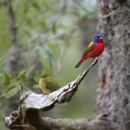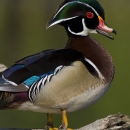Seasons of Wildlife
During the Spring months, look for raptors that can be spotted throughout the refuge. Alligators may be seen sunning in canals and on pond edges. Largemouth bass begin to move into shallow waters. Fishing is excellent for all species at this time of the year. Butterflies and dragonflies can be seen everywhere in April. Both painted and indigo buntings as well as orioles, tanagers, vireos, and grosbeaks have returned, and warblers are migrating through the area. Spring migration continues into May and nesting is in full swing.
During the Summer, fish begin to seek cooler waters. Fishing can be more challenging in the summer heat, but panfish can still be caught on the refuge. Bass, crappie, and catfish move further out into the deeper waters of Lake Marion. Many bird species are rearing young, and young birds are practicing their skills and learning how to survive. Shorebirds begin to return from their northern nesting grounds and can be seen in refuge impoundments and on lake edges. In August, redbugs, biting flies, and mosquitoes are voracious.
With the Fall, comes the migration of warblers traveling south and the arrival of raptors, cormorants, and white-throated and song sparrows. Ruby-crowned kinglets and yellow-rumped warblers are common to sight. Waterfowl are arriving in flocks, with Bald eagles frequently sighted around concentrations of ducks. White-tailed deer rutting begins as bucks start to rub the velvet off their antlers. Striped bass are schooling, and catfishing is excellent in the fall. Large concentrations of waterfowl are present and sandhill cranes may be observed on the Bluff Unit. Fishing opportunities are excellent for largemouth bass, striped bass, and catfish.
In the Winter season, waterfowl concentrations peak, migratory Canada geese feast in refuge wheat fields, and ducks and coots can be seen in the impoundments and nearby bays and creeks. Wintering grassland birds like sparrows, juncos, and flycatchers are abundant. In late February, waterfowl can be observed foraging to build energy reserves before starting their long migrations north. Crappie begin to move into the creeks and striped bass are schooling. Wood ducks, purple martins, and bluebirds begin to look for nesting cavities.
Featured Species
Santee NWR is a great place to get outdoors and get immersed in the natural world around you. Visitors come to Santee NWR in anticipation of seeing wildlife here on the refuge. The diverse habitats on the refuge support many kinds of wildlife. The refuge is home to nearly 300 bird species, more than 100 species of fish, 50 mammals species, 54 reptile species and 35 amphibian species. The forest provides a home for white-tailed deer and other woodland creatures, such as raccoons, squirrels, and bobcats. The ponds and marshes provide a home for alligators and a number of other reptiles, and amphibians such as the spotted salamander. You may see the federally threatened wood stork, as well as bald eagles and wood ducks.
Painted Bunting
Painted buntings are breeding migrants at Santee NWR. The eastern painted bunting has been identified as one of the highest priority species in need of conservation in the southeast. They require early successional habitat including grasses, shrubs, fallow fields, and transitional zones like woodland edges between open lands and forested woods. Though painted bunting populations appear to be declining throughout the southeast, they seem relatively abundant at Santee NWR. They typically arrive from their wintering grounds in mid-April to establish nesting territories on the refuge.
Prescribed burns, invasive species invasive species
An invasive species is any plant or animal that has spread or been introduced into a new area where they are, or could, cause harm to the environment, economy, or human, animal, or plant health. Their unwelcome presence can destroy ecosystems and cost millions of dollars.
Learn more about invasive species work and other habitat management in grasslands/fields and shrublands on the refuge help to provide suitable habitat for painted buntings. Grassy fields are important foraging areas for post-breeding adults and fledglings. Edge habitat, grassy forest openings and forested stands provide structural habitat diversity and a variety of fruit, seeds, insects and invertebrates for painted bunting on the refuge.
Wood Stork
Wood storks (Mycteria americana) were listed as endangered on February 28, 1984, pursuant to the Endangered Species Act of 1973, as amended. The status of the Wood Stork was reviewed by the U.S. Fish and Wildlife Service in 2007, and in 2010, and it was reclassified as threatened rather than Endangered. The reclassification to “threatened” does not change the protection that the wood stork receives under the Endangered Species Act, but it is a step toward delisting the species. Wood stork is also listed as threatened under the South Carolina Nongame and Endangered Species Conservation Act, and a highest priority species of conservation concern.
Wood storks have suffered from habitat loss and destruction in areas such as southern Florida. The loss of feeding habitat due to the alteration of natural hydroperiods has resulted in the abandonment of nesting colonies or widespread nesting failures in south Florida. Development, lowered water tables and disturbance has also degraded nesting sites. Therefore, as their natural range has been reduced, South Carolina has become an attractive location for the continued survival of this species.
Santee NWR provides foraging and loafing habitat for wood storks in flooded croplands, ponds, managed impoundments, and forested wetlands. Wood storks are typically attracted to shallow open ponds where seasonally flooded wetlands provide food resources for them, other wading species, and shorebirds. The Wood Stork serves as an indicator species for successful wetlands management. High quality and quantity wetland habitat are key for the well-being of wood storks. Habitat availability and conservation for the wood stork also benefits a host of other waterbirds that rely on wetlands for survival.
Wood storks are mostly seen in the summer and fall months at Santee NWR, while a few birds may be seen during the winter. Wood storks have been breeding in South Carolina since the 1980s, but no breeding birds have been documented on the refuge so far. The refuge records general wood stork observations.
Wood Duck
The wood duck is a representative dabbling duck species at Santee NWR. Wood ducks can be found in large numbers year-round with breeding populations on the refuge. Wood ducks utilize refuge impoundments, flooded croplands, and forest wetlands (bottomland hardwoods/green tree reservoirs). Wood ducks forage on acorns, other soft and hard mast, vegetative seeds, and invertebrates. They loaf and roost in more secluded areas and dense shrub swamps. Brood survival is higher where nests are close to water.
The refuge supports a healthy wood duck population, with a variety of wetland habitats that are used by wood ducks and other duck species. Providing a wetland complex with habitat diversity is important and enhances the refuge’s ability to provide optimal habitat for wintering, breeding, brood-rearing, migrating and year-round use. Wood duck use is recorded during wintering waterfowl surveys and noted in general observations.
The refuge also invests time and resources in providing nest boxes for wood ducks to use as artificial nesting cavities. Fewer natural cavities are available due to deforestation, development, and competition for nest sites from a host of other species. Natural cavities are the primary limiting factor to successful reproduction. Populations currently appear stable, but are threatened by reduced wetlands, habitat loss, and development. While nest boxes help to supplement natural cavities and increase local production of wood ducks, they require time to clean and repair at least annually. The refuge currently manages and monitors nest boxes as staff, timing and resources are available.
The refuge wood duck banding program is one of the best long-term data sets for this species in the southeast. Santee NWR is one of the most, successful wood duck banding sites with the highest annual quota and birds banded in the United States. More than 22,000 wood ducks have been banded at Santee NWR, with the aid of a successful rocket netting program. Annual banding is currently conducted on the refuge as staff, timing and resources are available.






